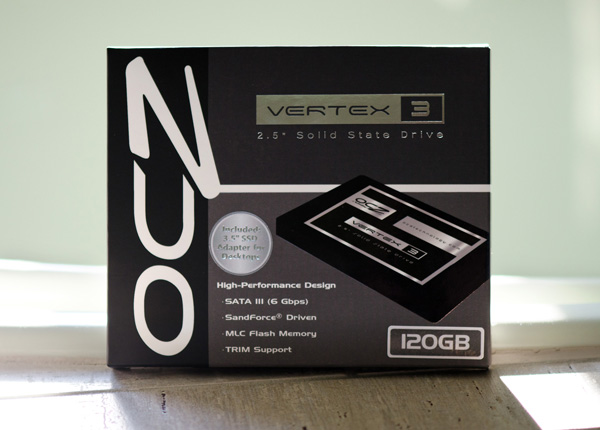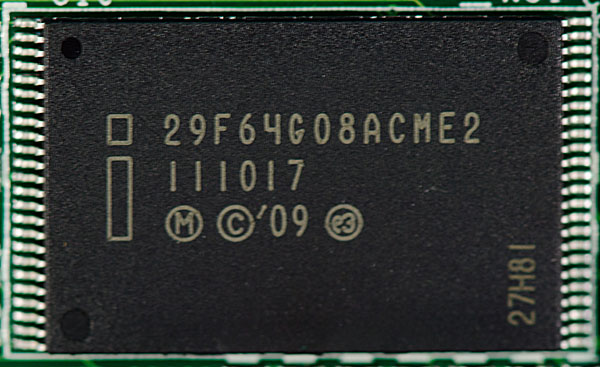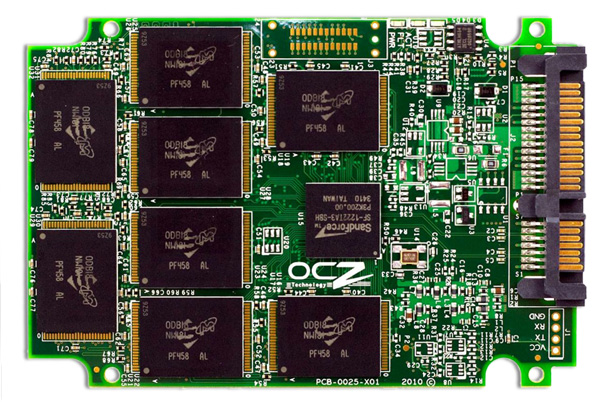The OCZ Vertex 3 Review (120GB)
by Anand Lal Shimpi on April 6, 2011 6:32 PM ESTSandForce was first to announce and preview its 2011 SSD controller technology. We first talked about the controller late last year, got a sneak peak at its performance this year at CES and then just a couple of months ago brought you a performance preview based on pre-production hardware and firmware from OCZ. Although the Vertex 3 shipment target was originally scheduled for March, thanks to a lot of testing and four new firmware revisions since I previewed the drive, the officially release got pushed back to April.
What I have in my hands is retail 120GB Vertex 3 with what OCZ is calling its final, production worthy client firmware. The Vertex 3 Pro has been pushed back a bit as the controller/firmware still have to make it through more testing and validation.
I'll get to the 120GB Vertex 3 and how its performance differs from the 240GB drive we previewed not too long ago, but first there are a few somewhat-related issues I have to get off my chest.
The Spectek Issue
Last month I wrote that OCZ had grown up after announcing the acquisition of Indilinx, a SSD controller manufacturer that was quite popular in 2009. The Indilinx deal has now officially closed and OCZ is the proud owner of the controller company for a relatively paltry $32M in OCZ stock.
The Indilinx acquisition doesn't mean much for OCZ today, however in the long run it should give OCZ at least a fighting chance at being a player in the SSD space. Keep in mind that OCZ is now fighting a battle on two fronts. Above OCZ in the chain are companies like Intel, Micron and Samsung. These are all companies with their own foundries and either produce the NAND that goes into their SSDs or the controllers as well. Below OCZ are companies like Corsair, G.Skill, Patriot and OWC. These are more of OCZ's traditional competitors, mostly acting as assembly houses or just rebadging OEM drives (Corsair is a recent exception as it has its own firmware/controller combination with the P3 series).
By acquiring Indilinx OCZ takes one more step up the ladder towards the Intel/Micron/Samsung group. Unfortunately at that level, there's a new problem: NAND supply.
NAND Flash is not unlike any other commodity. Its price is subject to variation based on a myriad of factors. If you control the fabs, then you generally have a good idea of what's coming. There's still a great deal of volatility even for a fab owner, process technologies are very difficult to roll out and there is always the risk of issues in manufacturing, but generally speaking you've got a better chance of supply and controlled costs if you're making the NAND. If you don't control the fabs, you're at their mercy. While buying Indilinx gave OCZ the ability to be independent of any controller maker if it wanted to, OCZ is still at the mercy of the NAND manufacturers.
Currently OCZ ships drives with NAND from four different companies: Intel, Micron, Spectek and Hynix. The Intel and Micron stuff is available in both 34nm and 25nm flavors, Spectek is strictly 34nm and Hynix is 32nm.
Each NAND supplier has its own list of parts with their own list of specifications. While they're generally comparable in terms of reliability and performance, there is some variance not just on the NAND side but how controllers interact with the aforementioned NAND.
Approximately 90% of what OCZ ships in the Vertex 2 and 3 is using Intel or Micron NAND. Those two tend to be the most interchangeable as they physically come from the same plant. Intel/Micron have also been on the forefront of driving new process technologies so it makes sense to ship as much of that stuff as you can given the promise of lower costs.
Last month OWC published a blog accusing OCZ of shipping inferior NAND on the Vertex 2. OWC requested a drive from OCZ and it was built using 34nm Spectek NAND. Spectek, for those of you who aren't familiar, is a subsidiary of Micron (much like Crucial is a subsidiary of Micron). IMFT manufactures the NAND, the Micron side of it takes and packages it - some of it is used or sold by Micron, some of it is "sold" to Crucial and some of it is "sold" to Spectek. Only Spectek adds its own branding to the NAND.
OWC published this photo of the NAND used in their Vertex 2 sample:
I don't know the cause of the bad blood between OWC and OCZ nor do I believe it's relevant. What I do know is the following:
The 34nm Spectek parts pictured above are rated at 3000 program/erase cycles. I've already established that 3000 cycles is more than enough for a desktop workload with a reasonably smart controller. Given the extremely low write amplification I've measured on SandForce drives, I don't believe 3000 cycles is an issue. It's also worth noting that 3000 cycles is at the lower end for what's industry standard for 25nm/34nm NAND. Micron branded parts are also rated at 3000 cycles, however I've heard that's a conservative rating.
If you order NAND from Spectek you'll know that the -AL on the part number is the highest grade that Spectek sells; it stands for "Full spec w/ tighter requirements". I don't know what Spectek's testing or validation methodology are but the NAND pictured above is the highest grade Spectek sells and it's rated at 3000 p/e cycles. This is the same quantity of information I know about Intel NAND and Micron NAND. It's quite possible that the Spectek branded stuff is somehow worse, I just don't have any information that shows me it is.
OCZ insists that there's no difference between the Spectek stuff and standard Micron 34nm NAND. Given that the NAND comes out of the same fab and carries the same p/e rating, the story is plausible. Unless OWC has done some specific testing on this NAND to show that it's unfit for use in an SSD, I'm going to call this myth busted.













153 Comments
View All Comments
soltys - Thursday, April 14, 2011 - link
Looking at past few articles, I was wondering - what exactly do SSDs do, that random writes are significantly faster than random reads (and looking at the tables above, 2x - 3x faster) ?Even considering magic firmware + spare space + caching - sooner or later R-E-M-W will have to be performed. And random patterns, with random data should emphasize that.
Any insights or pointers ?
Norrin - Friday, April 15, 2011 - link
Hi Anand,I have the vertex 3 installed in a 2011 macbook pro.
I'm having a horrible problem where the OS locks up for about 10 seconds every 30 minutes or so.
What was the problem that cause OCZ to delay their March 3rd launch day??
What changes were made (firmware version numbers)? How can the firmware on a vertex 3 be checked and where can the latest version be downloaded and installed?
I suspect the problem I'm seeing is the same which delayed their launch. Maybe they have a firmware update available now which can be installed in the disk I currently have....
Thanks so much!
jammmet - Tuesday, April 19, 2011 - link
I am experiencing exactly the same issue - did you find a workaround? Also, do you also have a spinning HD in your machine too?typofonic - Monday, April 18, 2011 - link
Wouldn't a Vertex 3 120 GB be a really bad choice for a boot drive when it has such a low random read performance, compared to the older Force F120/Vertex, even if I have a new SATA3 MacBook Pro?I can imagine that launching applications, booting the system etc. would be much slower with this compared to a Vertex 2/Corsair Force F120. Yes, the sequential performance is much better, but wouldn't the older drives seem snappier in normal everyday use?
Even if the Vertex 3 120GB cost the same as a Vertex 2/Force F120, wouldn't the older drives still be a much better choice for normal use, because of their high random read/write? Can't decide if I should go for the Vertex 3 or the Force F120/Vertex 2.
Anybody who knows more about this?
rgbxyz - Wednesday, April 20, 2011 - link
I own a 120 GB Vertex. I've been thinking about adding another one. However, it will not be an OCZ. With the word coming, that it seems. and I stress, seems, that OCZ can not once again be trusted. And this time around it's an even bigger issue.From the just released report: "OCZ has parlayed investor and market excitement for solid state drives (SSDs) into an amazing story. From a low of $1.79 last summer, OCZ's stock has steadily climbed more than 350% on a feel good tale told by its CEO. But there is a much darker and sinister side that has been well hidden. It is our opinion that OCZ has misrepresented its SSD growth and has financial irregularities that are nearly impossible to reconcile. We believe that some form of a restatement may be required and that the auditors tick and tie review has some substantial inconsistencies. As such, we have sent our findings to the Securities and Exchange Commission asking for clarification on the multiple sets of numbers that we have uncovered. We believe OCZ's Board has the fiduciary responsibility to form a special committee to examine these discrepancies." The bottom line for those curious where this short-seller sees the stock: "If OCZ trades in-line with the comp group, a generous assumption given OCZ's limited asset value, differentiation, and minimal profitability, a reasonable price target would be between $2.58 and $4.98 per share."
http://www.scribd.com/doc/53435574/OCZ-The-Master-...
la taupe - Friday, April 22, 2011 - link
http://www.scribd.com/doc/53435574/OCZ-The-Master-...geroj - Saturday, April 23, 2011 - link
it would be interesting to see if 2 120gb ssd-s in raid0 would be better choice over a 240gb vertex3 or intel 510 (performance and costwise).im thinking of putting 2x120gb crucial c300 in raid0, it would cost 2/3rd of a 240gb vertex3 but a thorough test would be nice before deciding.
2x64gb in raid0 is also enough for me (and as i see for a lot of us) but what about the performance?
ekerazha - Wednesday, April 27, 2011 - link
New "Vertex 3 Max IOPS" series released.120 GB
Read IOPS: 20.000 -> 35.000
Write IOPS: 60.000 -> 75.000
240 GB
Read IOPS: 40.000 -> 55.000
Write IOPS: 60.000 -> 65.000
Max Write: 520 MB/s -> 500 MB/s (decrease)
sor - Friday, April 29, 2011 - link
Yeah, what the hell is this all about? Anand mentioned in his review that there was supposed to be some sort of firmware cap on iops according to sandforce, but that his test vertex3 didn't have it, and that OCZ promised that performance of the shipping drive would be identical. Turns out apparently that they had TWO versions they were going to ship, and everyone was apparently led to believe that the test review one was the same performer that everyone has been jumping on as fast as they can ship. I think we've been duped.spensar - Saturday, April 30, 2011 - link
Love the real world benchmarks, and would like to see the Vertex 2 120gb numbers put up in the comparisions as well.